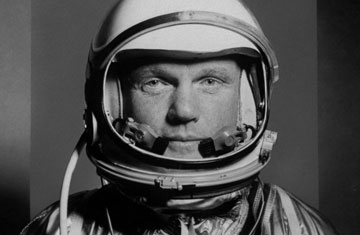
Astronaut John Glenn in space suit
John Glenn used to keep a little toy in his office during his years as a U.S. Senator. It was a model of his Mercury spacecraft — the capsule dubbed Friendship 7 — that he rode into orbit on February 20, 1962. The model was remarkable for its detail and its historical significance, but the most extraordinary thing about it was a small plaque affixed to its stand. "Scale: 1:9," it said. Magnify that model ninefold and all you do is turn it from a small toy to a big toy, and yet 50 years ago this month, Glenn risked his neck aboard such a thing all the same.
The Mercury astronauts never much cared for the term space capsule. There was a passivity about it, and test pilots aren't passive people. A bathysphere is a capsule; a sarcophagus is a capsule. A spacecraft is a vehicle, thank you very much, and it ought to be described that way. Still, there was no overstating the tininess of this particular vehicle. It may have been 9 ft. tall and 6 ft. 3 in. wide at its base, but most of that volume was stuffed with instrumentation. The habitable space was so cramped that, as the old joke went, you didn't so much climb inside a Mercury spacecraft as put it on.
The Atlas rocket that lofted the spacecraft was no luxury ride either. First of all, it was intended to be used as an intercontinental ballistic missile — not something designed with the comfort of a passenger in mind. Its skin was so thin its sides could collapse if it weren't filled with fuel. That kept weight down but made for an awfully flimsy machine. And the Atlases had an unfortunate habit of blowing up on launch. But never mind, Glenn agreed to fly one.
God Speed, John Glenn: Americans in Orbit
His mission, now half a century old, has long been a signal moment in America's 20th century history. That the country felt a deep, urgent need to get men into orbit is a defining fact of that era too — as the U.S. and the USSR faced off across a two-power world in which space had become the highest hill that could be captured in a not-yet-shooting war.
So Glenn flew, in a little ship atop balky booster, spending a total of 5 hr. and 16 min. aloft, as he orbited the planet three times. The return to Earth turned out to be bumpier than the controllers had planned. A light on Glenn's instrument panel warned him that his heat shield — the only thing that would protect him from his fireball plunge through the atmosphere — was loose. As a precaution, NASA ordered him not to jettison his retrorockets before re-entry. The little bundle of ordnance — which was fired once to slow his speed and ease him out of orbit — was strapped in place over the heat shield. The hope was that it would keep everything where it was supposed to be until it burned away during the fall to Earth, after which air pressure would do the job. As it turned out, the light was a false alarm, and when the spacecraft finally hissed into the cold water of the Atlantic Ocean, the heat shield was found to be intact.
Friendship 7 is at the Smithsonian National Air and Space Museum in Washington, D.C., today. It's encased in a plastic shell so you can't touch the heat shield, but you can see it up close — still scarred with the sunburst-like rays that speak to the hellfire it felt in 1962. Back then, all heat shields were what's known as ablative — meaning they were designed to disintegrate, burning off slowly and carrying the heat away from the vehicle. In theory, you could melt away the whole shield and have nothing left; in practice, there was always more than enough ablative material to keep the passengers safe.
Still, there was something gloriously self-consuming about the old heat shields — something that captured the early days of the space age as a whole. Rockets would be used once and dropped in the drink; exploding bolts would separate the stages on the way up. The need was too great, the pace was too fast to worry about doing things more delicately. Ultimately — and inevitably — people were consumed too: the Apollo 1 crew; the Columbia and Challenger crews; Charlie Bassett and Elliot See, two Gemini astronauts who died in training jets before they could ever get to space and yet pushed the program along all the same.
But John Glenn has survived and his spacecraft has survived. At 9:27 a.m. E.T. this February 20, pause to take a glance at a clock. Glance again at 2:43 p.m. Those are the hours of Glenn's liftoff and splashdown. That's far too short a span to define a life — but it's more than enough to exemplify it.
